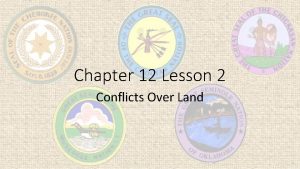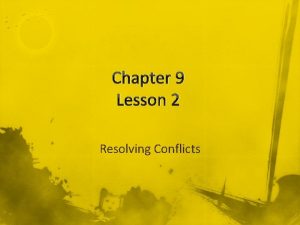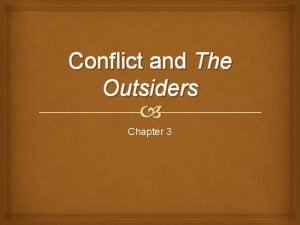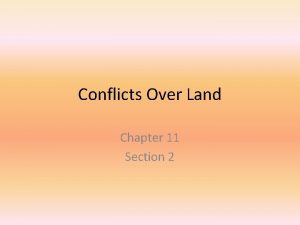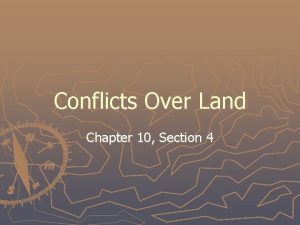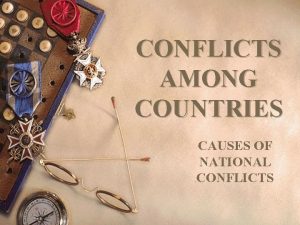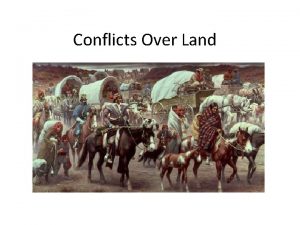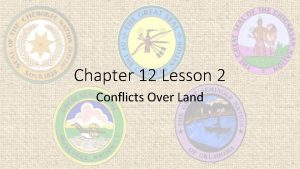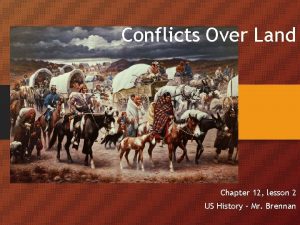Conflicts Over Land Chapter 11 Lesson 2 Moving











- Slides: 11

Conflicts Over Land Chapter 11, Lesson 2

Moving Native Americans ► While American moved west many Native Americans still lived in the eastern part of the country. § In Georgia, Alabama, Mississippi, and Florida lived the “Five Civilized Tribes. ” (Cherokee, Creek, Seminole, Chickasaw, and Choctaw) ► Had an established farming society with successful economies. The land west of the Mississippi was dry and seemed unsuitable for farming, so few white Americans lived there. ► Many Americans wanted the federal government to relocate the Natives to leave their land settle the lands west of the Mississippi. ► § Andre Jackson supported the settlers’ demand for the Native American land.

Indian Removal Act (1830) – The act allowed the federal government to pay the Native Americans to move west. ► Jackson sent officials to negotiate treaties with the Native Americans in the Southeast. ► § Most felt compelled to accept payment for their lands. ► In 1834 Congress created the Indian Territory, an area in present-day Oklahoma, for Native Americans from the Southeast.


The Cherokee Nation ► The Cherokee Nation refused to give up its land. § It had made treaties with the federal government recognizing them as a separate nation with their own laws. § Georgia refused to recognize their laws. ► Worcester v. Georgia (1832) – Chief Justice John Marshall ruled that Georgia had no right to interfere with the Cherokee. § Only the federal government had authority over matters involving the Cherokee. ► In support of Georgia’s efforts to remove the Cherokee, President Jackson vowed to ignore the Supreme Courts ruling stating, “John Marshall has made his decision… Now let’s see him enforce it. ”

The Trail of Tears ► In 1835, the federal government convinced a few Cherokee to sign a treaty giving up their people’s land. § 17, 000 Cherokee refused to honor the treaty. § They wrote a protest letter to the government and the people of United States: “We are aware that some persons suppose it will be for our advantage to [re]move beyond the Mississippi… Our people universally think otherwise… We wish to remain on the land of our fathers. ” ► President Jackson and the white settlers of the area did not soften up with this plea. § In 1838, General Winfield Scott and army of around 7, 000 federal troops came to remove their homes and lead them west. § Scott threatened to use force telling them he had them surrounded, that resistance or escape was futile and an attempt to would resort to them using arms.

The Trail of Tears The Cherokee knew that fighting would only lead to destruction. ► With sadness and anger, the leaders gave in. and began their long escort to the West. ► § A man from Kentucky witnessing the march of hundreds of Cherokee wrote: “Even [the] aged… nearly ready to drop in the grave, were traveling with heavy burdens attached to their backs, sometimes on frozen ground and sometimes on muddy streets, with no covering for their feet. ” ► Intense weather along the way killed thousands of Cherokee and this forced journey out west became known to their people as the Trail Where They Cried (Historian call it the Trail of Tears. )

Native American Resistance In 1832, The Sauk chieftain, Black Hawk, led a force of Sauk and Fox people back to Illinois (to get their homeland back that was given up in a treaty. ) § They were met with a combined force of 4, 500 soldiers of state militia and federal troops. § They chased them down the Mississippi River and slaughtered most of the Natives who tried to flee westward into present-day Iowa. ► The Seminole people were the only group to successfully resist removal. § They were pressured like the other groups but Seminole chief Osceola, and some of his people refused to leave Florida. § In 1835, they combined with a group of runaway African Americans who escaped slavery. ► They used guerilla tactics to attack coastal settlements. ► In December 1835, they ambushed soldier led by Major Francis Dade leaving only a few of the 110 soldiers surviving. ► The Dade Massacre pressured for more troops and equipment to fight the Seminole. ►

Native American Resistance ► By 1842, more than 1, 500 American soldiers had died in the Seminole wars. § The government gives up and allows some of the Seminole to remain in Florida. The long war took its toll on the Seminole as well, as many had died in the long war, and others were captured and forced to move westward. ► After 1842, only a few scattered groups remained east of the Mississippi. ► Native Americans had given up more than 100 million acres of eastern land to the federal government. ► § They received $68 million and 32 million acres in lands west of the Mississippi River where they lived, divided by tribes, in reservations. § Even then, these areas would face intrusion from white civilization.

Native American Resistance ► With the Louisiana Purchase, the area of present-day Oklahoma became part of the U. S. in 1803. § This land was set aside for the various Native American groups. ► The Five Civilized Tribes were relocated in the eastern half of present-day Oklahoma on lands claimed by several Plains groups, including the Osage, Comanche, and Kiowa. § U. S. Army leaders got agreements from the Plains group to allow the relocated tribes live in peace. ► The Five Tribes developed their governments, improved their farms, and built schools as well as developed a police force called the Lighthorsemen that maintained safety for the region.

 Chapter 12 lesson 2 conflicts over land
Chapter 12 lesson 2 conflicts over land Chapter 9 lesson 2 resolving conflicts
Chapter 9 lesson 2 resolving conflicts Chapter 9 lesson 2 resolving conflicts
Chapter 9 lesson 2 resolving conflicts Modified union shop definition
Modified union shop definition Biome
Biome The move west continues
The move west continues What are landforms
What are landforms An area of land largely enclosed by higher land
An area of land largely enclosed by higher land Chapter 18 section 4 conflicts in the middle east
Chapter 18 section 4 conflicts in the middle east Chapter 9 resolving conflicts and preventing violence
Chapter 9 resolving conflicts and preventing violence Internalconflict definition
Internalconflict definition A perennial mass of ice which moves over land
A perennial mass of ice which moves over land
